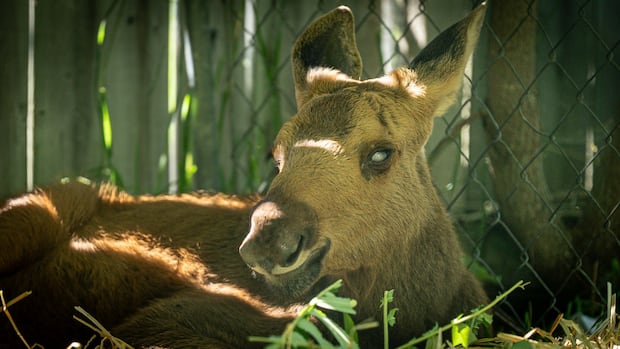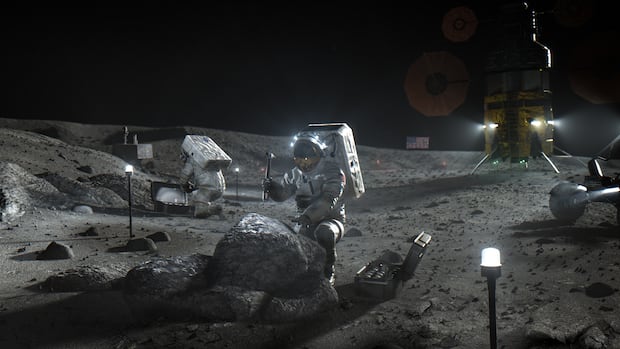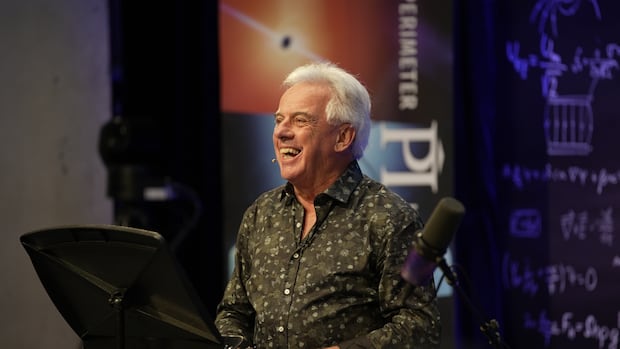A wildlife rescue in Ottawa is hoping the province will allow it to transfer a blind baby moose to the Toronto Zoo to live out its days in captivity, or it may be forced to euthanize it.
The two-month old moose was found earlier this month on a rural road and brought to Holly’s Haven Wildlife Rescue, where staff gave it the name Cedar.
“He was walking through a field, calling out, probably calling out trying to find his mother and … she was nowhere to be seen,” said Lynne Rowe, director of operations at Holly’s Haven.
Veterinarians determined Cedar was entirely blind in one eye and has only partial vision in the other, meaning he likely won’t be able to safely return to the wild, Rowe said.
“For Cedar, if he was released in the wild, he’d be readily predated pretty quickly. He wouldn’t survive long,” Rowe said.
Ottawa MorningThe rescue of Cedar, the blind baby moose
Few people can say they’ve come face-to-face with a moose in the wild. And even fewer can say they saved a moose’s life. But Rob Boisvert has done both.
The rescue is only licensed to rehabilitate animals and care for them until they can be released — not to care for animals in captivity, Rowe said.
Province must decide if Cedar can be kept in captivity
They also don’t have the space. While Cedar is only about 60 kilograms now, a full-grown moose can stand up to six feet tall and weigh as much as 725 kilograms.
“I will not be able to keep him when he grows much bigger. It costs a lot to feed him and I want him to have to not feel too confined,” Rowe said.
So, Rowe reached out to the Toronto Zoo, which currently has an empty moose enclosure, to see if it could provide a home for Cedar to live out his days in captivity.
While the zoo says it would be willing to take Cedar in, whether it will be allowed to do so is up to Ontario’s Ministry of Natural Resources, which must sign off on classifying Cedar as unreleaseable to allow the zoo to keep him in captivity.
Otherwise, Rowe said Cedar will have to be euthanized.
“The only way the Toronto Zoo can take in an animal that’s native to Canada is in a circumstance like this. They cannot take healthy animals out of the wild or newborn animals that are perfectly healthy and can survive in the wild,” Rowe said.
CBC News reached out to the ministry about Cedar, but was referred to the Holly’s Haven Wildlife Rescue and Toronto Zoo.
Ideal outcome for Cedar to be releasable: zoo
The Toronto Zoo’s moose enclosure has been empty since its two moose Lily and Trilly died last year, said the zoo’s CEO Dolf Delong. But it will be up to the province to decide whether the Toronto Zoo would be a suitable home for Cedar.
Cedar also needs to be further assessed by veterinarians and animal care professionals to determine if that’s the best course of action for him, Delong said.
“The preferred outcome is maybe Cedar would be releasable,” Delong said.
“That said, they also have to make sure Cedar can still live a life where with those limited capabilities, [that] he can thrive.”
Delong said euthanasia would be the “last choice”, but may be necessary if veterinarians determine Cedar won’t be able to live comfortably in captivity long-term.
So far, Cedar seems to be doing well in captivity, which isn’t the case for all animals, Rowe said.
“In Cedar’s case, he seems pretty calm in his enclosure here, and I feel he would be able to adapt to a larger enclosure at the Toronto Zoo.”

Delong said he hopes that’s the case.
“We potentially could present an amazing forever home for Cedar if that’s what’s deemed the appropriate next step for him.”







